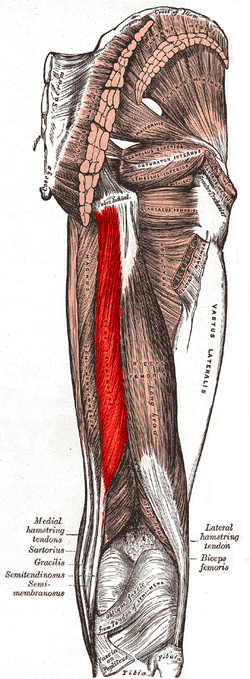Musculus semitendinosus
| Semitendinosus muscle | |
|---|---|

Muscles of the gluteal and posterior femoral regions. Semitendinosus labeled at bottom left.
|
|

Horizontal section of left thigh, viewed from above. Semitendinosus visible at bottom right.
|
|
| Details | |
| Origin | Tuberosity of the ischium |
| Insertion | Pes anserinus (tibia) |
| Artery | Inferior gluteal artery, perforating arteries |
| Nerve | Sciatic (tibial, L5, S1, S2) |
| Actions | Flexion of knee, extension of the hip joint |
| Antagonist | Quadriceps muscle |
| Identifiers | |
| Latin | Musculus semitendinosus |
| Dorlands /Elsevier |
m_22/12550732 |
| TA | A04.7.02.035 |
| FMA | 22357 |
|
Anatomical terms of muscle
[]
|
|
The semitendinosus (/ˌsɛmitɛndɪˈnoʊsəs/) is a long superficial muscle in the back of the thigh. It is so named because it has a very long tendon of insertion. It lies posteromedially in the thigh, superficial to the semimembranosus.
The semitendinosus, remarkable for the great length of its tendon of insertion, is situated at the posterior and medial aspect of the thigh.
It arises from the lower and medial impression on the upper part of the tuberosity of the ischium, by a tendon common to it and the long head of the biceps femoris; it also arises from an aponeurosis which connects the adjacent surfaces of the two muscles to the extent of about 7.5 cm. from their origin.
The muscle is and ends a little below the middle of the thigh in a long round tendon which lies along the medial side of the popliteal fossa; it then curves around the medial condyle of the tibia and passes over the medial collateral ligament of the knee-joint, from which it is separated by a bursa, and is inserted into the upper part of the medial surface of the body of the tibia, nearly as far forward as its anterior crest.
...
Wikipedia
